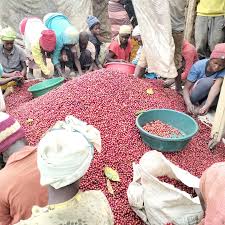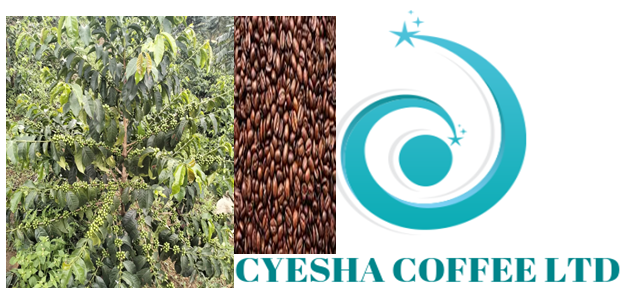At Cyesha Coffee Ltd., our flagship product is premium specialty Arabica coffee, renowned for its exceptional quality and unique flavor profile. Our commitment to excellence begins at the source, with coffee cherries meticulously sourced from both our expansive coffee plantations and from dedicated local smallholder farmers within Rwanda’s esteemed Kivu Belt. This dual sourcing strategy ensures a consistent supply of high-grade cherries while fostering strong community partnerships.
The journey of our specialty coffee from a vibrant red cherry to a ready-for-market bean is a testament to our dedication to quality, sustainability, and precision. We primarily employ the Fully Washed Method, a process critical to achieving the clean, bright, and complex flavor profiles characteristic of high-end Rwandan Arabica.
Here’s a detailed breakdown of our processing journey
Cherry Reception & Initial Sorting
Upon arrival at our modern Coffee Washing Stations (CWS), fresh coffee cherries undergo rigorous inspection. Our trained team meticulously hand-sorts the cherries, removing any under-ripe, over-ripe, or damaged cherries, as well as foreign matter. Only the perfectly ripe, red cherries are accepted for processing, ensuring the highest quality foundation.

Depulping
The sorted cherries are then fed into high-capacity mechanical depulpers. These machines gently remove the outer skin and most of the pulp from the coffee cherry, leaving behind the beans encased in a sticky, sugary layer called mucilage, still within their parchment.
Fermentation
The depulped beans, still covered in mucilage, are transferred to dedicated fermentation tanks (concrete or tiled). Here, naturally occurring enzymes and microbes break down the mucilage. This critical stage is precisely monitored for 12-24 hours (depending on environmental conditions) to achieve the desired flavor development without over-fermentation, which can lead to undesirable tastes.
Washing & Grading
Following fermentation, the beans are thoroughly washed through specialized channels. This process removes any remaining mucilage and, importantly, allows for initial grading. Beans are separated by density, with denser, higher-quality beans sinking and lighter, potentially defective beans floating away.
Soaking for Quality-Enhancement
After washing, the beans may undergo soaking period (12-18 hours) in clean water. This step is known to further enhance the uniformity of the beans, improve their internal structure, and contribute to a cleaner, brighter cup profile.
Drying (Parchment Coffee)
The wet parchment coffee (beans still encased in their protective parchment layer) is then carefully spread out on extensive raised drying beds, often referred to as “African beds.” This allows for slow, even drying under controlled conditions. The coffee is regularly turned to ensure uniform drying and prevent mold growth. Retractable shade netting is utilized to protect the beans from harsh direct sunlight or unexpected rain. This stage typically takes 10-14 days until the coffee reaches an optimal moisture content of approximately 11%
Dry Milling
Once the parchment coffee is fully dried, it is transported to the coffee dry mill equipped with advanced machinery for:
- Hulling: The dry parchment layer is gently removed, revealing the green coffee bean.
- Destoning: Machines effectively remove any small stones or heavy impurities that might have inadvertently mixed with the beans.
- Gravity Separation: Advanced gravity separators further refine the batch by separating beans based on density, ensuring only the highest quality, uniform beans proceed.
- Color Sorting: State-of-the-art optical color sorters are employed to meticulously identify and remove any defective beans based on color and shape with high accuracy, a crucial step for specialty coffee.
- Sizing/Grading: Automated sizers and graders sort the green beans by size, adhering to international standards for consistent quality.
Quality Control (Cupping Lab)
Throughout the process, and especially after dry milling, we take our coffee to the comprehensive cupping lab. Experienced cuppers rigorously evaluate samples for aroma, flavor, acidity, body, balance, and overall quality. This continuous sensory evaluation ensures consistency, identifies unique flavor profiles, and confirms that our coffee meets the stringent standards of the specialty market.
Packaging (Green Coffee for Export)
The meticulously processed and graded green coffee beans are then carefully packaged into export-grade jute or GrainPro bags. These bags are designed to protect the coffee from moisture, pests, and external odors, preserving its quality during transit to international markets.
